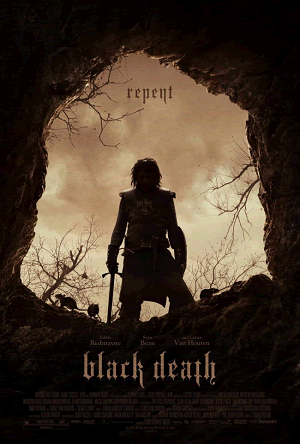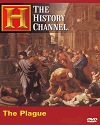| Black Death (2010) Educator Guide |
|---|
| www.studenthandouts.com ↣ World History ↣ Plague and Black Death ↣ Plague Books and Films |
 Release date: 2010
Release date: 2010
Length: 97 minutes (1 hour, 37 minutes) Age appropriateness: This film is rated R in the United States for scenes of death and violence. We would deem it "safe" for high school students (with parental consent) because the violence and brutality depicted fits the events of the story and historical period. That is, it would be difficult to make a movie about the bubonic plague without showing piles of corpses, etc. For those concerned about nudity, the most we saw was a brief glimpse of a woman's breasts through her blood-soaked dress. Creators and stars: Carice van Houten, Eddie Redmayne, Kimberley Nixon, Sean Bean Accuracy: This film is set in England in 1348, when the first bubonic plague outbreaks occurred in that country. We believe we heard the word "okay" used several times in the film, which of course bugged us because the film is set hundreds of years before this term entered the English language (via the natives of North America, who used it to indicate that a trade was settled). Additionally, the story contains quite a bit of "witch hunting" centuries before witch hunting was a "big deal" in Europe (hints of paganism were actually common and well-tolerated in the 14th century). These trivialities aside, the film is overall excellent at creating the mood of the pandemic known as the Black Death. Important aspects of the era are covered, such as the role of the medieval Church, differing reactions to the disease, as well as the appearance and scope of the plague. The film sets and scenery likewise do an excellent job of displaying how average people lived in the Middle Ages. Review: Watching this film, students will gain a good sense of how and why the plague spread quickly in cities, and more slowly in isolated rural areas. Students will also see great depictions of the buboes which infected the skin of the disease's victims. There is likewise a scene, early in the film, where the party of travelers witnesses a group of men whipping themselves in penitence. The movie also leaves a lot of room for the discussion of medieval religion and morality. A discussion might pose questions such as: In what ways was the Black Death viewed as a punishment from God? Compare and contrast modern and medieval views of witchcraft (i.e., any vestiges of pagan practices or disbelief in God could be interpreted as witchcraft then, whereas today the popular view of witches entails the use of actual magic, and in modern times, witches are often portrayed positively, such as in the Harry Potter books and films). While this movie does a terrific job of showing many of the different reactions Europeans had to the plague, it does not show all of them. The Church is shown only through the eyes of one character, a young monk who has been questioning his faith. There are no scenes to properly illustrate people's attempts to treat the illness. The movie does not give the viewer any history of the plague's spread. Therefore, educators and parents showing this film to students must treat it as a vignette in that it vividly portrays one small part of the whole, yet manages to convey, through its artistic impression, a larger part of this whole. So long as students are given the "basic facts" about the bubonic plague beforehand, this movie can do much to increase their comprehension and understanding. Miscellaneous: The work of the film's leading necromancer seems to succeed, and a woman appears to rise from the dead. Before viewing this film, it might be necessary to explain to students that medieval doctoring was imperfect (to say the least), and that it was very possible at the time for a living person to appear dead. In fact, it was not until the 18th century and the rise of modern medicine that doctors consciously set out to establish what were the signs of life, and to end the unfortunate yet common practice of accidentally burying people who were actually still alive. Click here to enlarge the official film poster. |
 |  |  |  |  |  |
| Black Plague Books and Films | Black Plague Outlines and PowerPoints |
| Black Plague Maps and Pictures | Black Plague Study Games |
| Black Plague Miscellany | Black Plague Worksheets |
| www.studenthandouts.com ↣ World History ↣ Plague and Black Death ↣ Plague Books and Films |








